2. Add Two Numbers
Medium
You are given two non-empty linked lists representing two non-negative integers. The digits are stored in reverse order, and each of their nodes contains a single digit. Add the two numbers and return the sum as a linked list.
You may assume the two numbers do not contain any leading zero, except the number 0 itself.
Example 1:

Input: l1 = [2,4,3], l2 = [5,6,4] Output: [7,0,8] Explanation: 342 + 465 = 807.
Example 2:
Input: l1 = [0], l2 = [0] Output: [0]
Example 3:
Input: l1 = [9,9,9,9,9,9,9], l2 = [9,9,9,9] Output: [8,9,9,9,0,0,0,1]
Constraints:
- The number of nodes in each linked list is in the range
[1, 100]. 0 <= Node.val <= 9- It is guaranteed that the list represents a number that does not have leading zeros.
풀이
1. LinkedList -> Python List로 변환하여 풀이
# Definition for singly-linked list.
# class ListNode:
# def __init__(self, val=0, next=None):
# self.val = val
# self.next = next
class Solution:
def addTwoNumbers(self, l1: ListNode, l2: ListNode) -> ListNode:
# LinkedList를 List로 만들기위한 변수설정
result = ''
l1_st = ''
l2_st = ''
# l1과 l2 링크드 리스트 스트링화
while l1 or l2:
if l1:
l1_st = str(l1.val) + l1_st
l1 = l1.next
if l2:
l2_st = str(l2.val) + l2_st
l2 = l2.next
# 결과값 Python 리스트화
result = list(str(int(l1_st)+int(l2_st)))
# 역순 LinkedList head
l = ListNode(result.pop())
# LinkedList Pointer
temp = l
# Python List -> LinkedList
# 맨뒤의 값 추출 -> Time Complexity O(1)
while result:
temp.next = ListNode(result.pop())
temp = temp.next
return l-
Python 리스트를 -> String -> LinkedList로 변환하여 풀이하였다.
-
역순으로 링크드리스트를 만드는 것은 Python리스트의 맨뒤값 추출(O(1))의 시간복잡도로 전체 O(n)의 시간복잡도이다.
2. 전가산기를 이용한 풀이
# Definition for singly-linked list.
# class ListNode:
# def __init__(self, val=0, next=None):
# self.val = val
# self.next = next
class Solution:
def addTwoNumbers(self, l1: ListNode, l2: ListNode) -> ListNode:
# root 노드
root = head = ListNode(None)
# 자리올림수
carry = 0
# 전가산기 과정
while l1 or l2 or carry:
sum = 0
if l1:
sum += l1.val
l1 = l1.next
if l2:
sum += l2.val
l2 = l2.next
# 몫과 나머지
carry, val = divmod(carry+sum, 10)
head.next = ListNode(val)
head = head.next
return root.next- 전가산기의 유사한 형태로 carry(자리 올림수)를 이용한 풀이이다.
배운점
- 컴퓨터의
+/-연산을 가산기와 전가산기를 논리회로를 이용하여 계산한다는 점을 배웠다.
Reference
- 컴퓨터는 어떻게 계산할까?
- 책 - 파이썬 알고리즘 인터뷰
